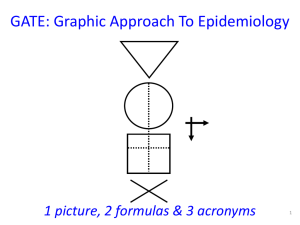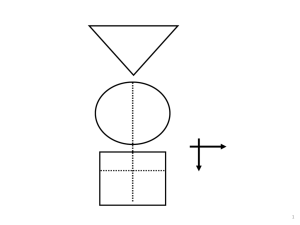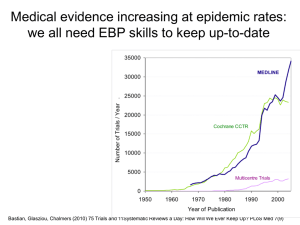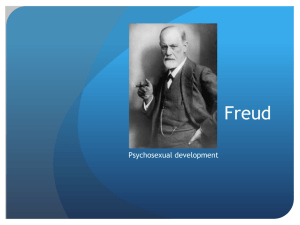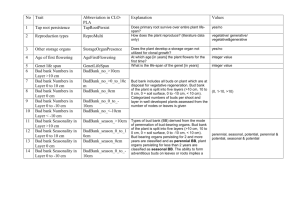Document
advertisement
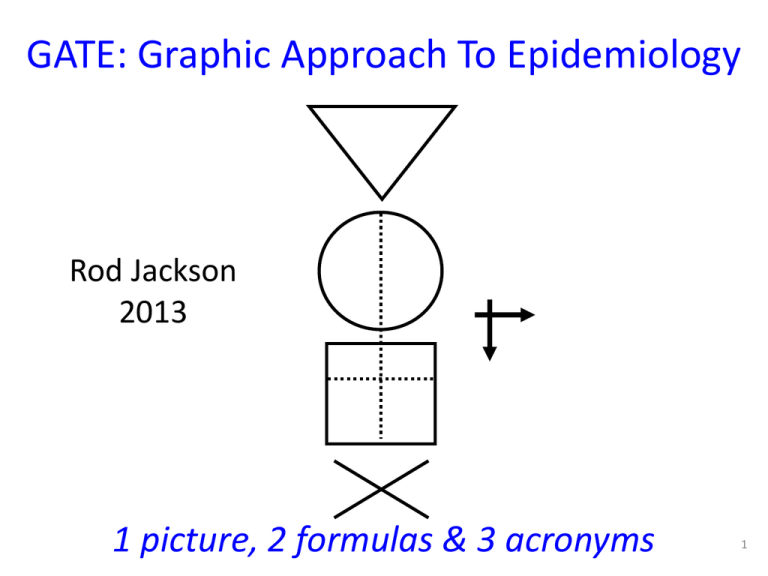
GATE: Graphic Approach To Epidemiology Rod Jackson 2013 1 picture, 2 formulas & 3 acronyms 1 The GATE frame: • Graphic Appraisal Tool for Epidemiological studies – a framework for appraising studies • Graphic Architectural Tool for Epidemiological studies – a framework for designing studies Presentation outline 1. a framework for study design 2. a framework for study analysis 3. a framework for study error 4. a framework for practicing EBP 1 picture, 2 formulas & 3 acronyms 1. GATE: design of epidemiological studies: the picture & 1st acronym: PECOT every epidemiological study can be hung on the GATE frame4 GATE Frame picture a cohort of British doctors smoking status measured (observed) smokers lung cancer events counted yes no non-smokers follow for 10 years longitudinal (cohort or follow-up ) study observational studies: allocated to groups by measurement 5 1st acronym: PECOT P British doctors Population/Participants smoking status measured Exposure smokers Outcomes Lung cancer yes no E C Comparison non-smokers O T Time 10 years 6 GATE Frame picture & 1st acronym P cohort of British doctors randomly allocated to aspirin or placebo aspirin heart attacks counted yes no E C placebo O T follow for 5 years randomised controlled trial RCT: allocated to E & C by randomisation process 7 GATE Frame picture & 1st acronym P Middle-aged Americans Body mass index measured overweight Diabetes status measured in all participants yes no E C ‘normal’ weight O T Cross-sectional (prevalence) study 8 GATE Frame picture & 1st acronym P Middle-aged Americans Body mass index measured Diabetes yes preno overweight obese E1 E2 C ‘normal’ weight O T Cross-sectional study (multiple categories) 9 GATE Frame picture & 1st acronym P Middle-aged Americans Body Mass Index (BMI) measured High BMI E C Low BMI high mean (average) Blood glucose low O T Cross-sectional study (with numerical outcome) 10 GATE Frame picture & 1st acronym P Middle-aged American women Receive Mammogram screening Test Mammogram positive E C Mammogram negative yes O Breast cancer no T Diagnostic (prediction) study 11 2. GATE: analysis of epidemiological studies: the 1st formula: outcomes ÷population the numbers in every epidemiological study can be hung on 12 the GATE frame 1st formula: Occurrence of outcomes = number of outcomes ÷ number in population/group British doctors P Participant Population smoking status measured Exposed Group EG CG Comparison Group smokers Outcomes Lung cancer non-smokers yes no a O b T Time 10 years 13 1st formula: occurrence = outcomes ÷ population P British doctors Population smoking status measured Exposed Group EG CG Comparison Group smokers Outcomes Lung cancer non-smokers yes no a O b T Time 10 years Exposed Group Occurrence (EGO) = a÷EG = number of outcomes (a) ÷ number in exposed population (EG) 14 1st formula: occurrence = outcomes ÷ population P British doctors Population smoking status measured Exposed Group EG CG Comparison Group smokers non-smokers yes Lung cancer no a O b Outcomes T Time 10 years Comparison Group Occurrence (CGO) = b÷CG = number of outcomes (b) ÷ number in comparison population (CG) 15 goal of all epidemiological studies is to measure (& compare) the occurrence of outcomes in (different) populations (EGO compared with CGO) P British doctors smoking status measured smokers yes EGO: Occurrence (risk) of cancer in smokers EG a CG non-smokers O b no Lung cancer 10 years T CGO: Occurrence of cancer in non-smokers 16 goal of all epidemiological studies is to measure (& compare) the occurrence of outcomes in (different) populations (EGO compared with CGO) P British doctors Randomly allocated to aspirin or placebo EG aspirin yes EGO: Occurrence of MI if taking aspirin no a CG O b placebo 5 years T Heart attack (MI) CGO: Occurrence of MI if not taking aspirin 17 goal of all epidemiological studies is to measure (& compare) the occurrence of outcomes in (different) populations (EGO compared with CGO) P Middle-aged Americans Body Mass Index (BMI) measured High BMI EGO: high Average blood glucose low in EG EG CG O Low BMI CGO: Average blood glucose in CG EGO = sum of all glucose levels in EG ÷ number in EG 18 goal of all epidemiological studies is to measure (& compare) the occurrence of outcomes in (different) populations (EGO compared with CGO) P Middle-aged American women receive Mammogram screening Test mammogram positive yes EGO: Occurrence of cancer if mammogram +ve EG CG a b O no Breast cancer mammogram negative T CGO: Occurrence of cancer if mammogram -ve 19 comparing EGO & CGO • Risk Ratio or Relative Risk (RR) = EGO ÷ CGO • Risk Difference (RD) = EGO – CGO • Number Needed to Treat/’expose’ (NNT) = 1 ÷ RD its all about EGO and CGO Measures of occurrence include: risk; rate; likelihood; probability; average; incidence; prevalence 3. GATE: identifying where errors occur in epi studies: the 2nd acronym: RAMBOMAN Recruitment Allocation Maintenance Blind Objective Measurements ANalyses GATE frame with RAMBOMAN can be used to identify risk of error in most/all epidemiological studies 21 Study setting RAMBOMAN Eligible population recruitment process P P were Recruited participants relevant to the study objectives? who are the findings applicable to? 22 RAMBOMAN: how well were participants Allocated to exposure & comparison groups? was Allocation to EG & CG successful? RCT: Allocated by randomisation (e.g to drugs) EG & CG similar? T Cohort: Allocated by measurement (e.g. smoking) EG CG EG CG O O T E&C measures accurate? 23 P EG CG O T RAMBOMAN how well were Participants Maintained in the groups they were allocated to (i.e. to EG & CG) throughout the study? completeness of follow-up compliance contamination co-interventions 24 P EG CG RAMBOMAN Were outcomes measured blind to whether participant was in EG or CG ? O T 25 RAMBOMAN P Were outcomes measured Objectively? EG CG O T 26 P RAMBOMAN Were the Analyses done appropriately? EG CG Adjustment for confounding O T 27 RAMBOMAN P EGA CGA EGC CGC Were the Analyses done appropriately? Intention to treat? b a O T 28 the 2nd formula: random error = 95% confidence interval EGO ± 95% CI CGO ± 95% CI There is about a 95% chance that the true value of EGO & CGO (in the underlying population) lies somewhere in the 95% CI (assuming no 29 non-random error) the 3rd acronym: FAITH Critically appraising a systematic review • Find – were all potentially relevant studies found? • Appraise – were studies appraised for validity? • Include – were only appropriate studies included in the final analyses? • Total-up – were studies pooled appropriately? • Heterogeneity – were studies too heterogeneous (i.e. too different) to pool? 4. GATE : a framework for the 4 steps of EBP the steps of EBP: 1. ask 2. access 3. appraise 4. apply [5. audit your practice] EBP Step 1: ASK - turn your question into a focused 5-part PECOT question P 2. Exposure 4. Outcomes E yes no 1. Participants C 3. Comparison O T 5. Time 33 EBP Step 2: ACCESS the evidence – use PECOT to help choose search terms 1. 2. 3. 4. 5. Participants Exposure Comparison Outcome Time frame 34 EBP Step 3: APPRAISE the evidence – with the picture, acronyms & formulas P Recruitment P Allocation E Maintenance E C blind objective O T C O T Measurements ANalyses Occurrence = outcomes ÷ population Random error = 95% Confidence Interval 35 EBP Step 4: APPLY the evidence by AMALGAMATING the relevant information & making an evidence-based decision:’ the X-factor © X-factor: making evidence-based decisions epidemiological evidence person values & preferences family community system features economic legal political patient’s clinical circumstances practitioner X Practitioner e pertise: ‘putting it all together’ - the art of practice Clinical expertise in the era of evidence-based medicine and patient choice. EBM 2002;736-8 (March/April) 6-page GATE CATs (word docs) 39 1-page GATE Calculators (excel files) 40 1-page GATE-lites (writeable pdf files) all forms on Cecil EBM site 41 extra slides GATE Frame picture & 1st acronym P smokers E C non-smokers smoking status measured cases yes O Lung cancer controls T no Case-control study Observational study: allocated by measurement 44 GATE Frame picture & 1st acronym P Middle-aged American women Measured with ‘gold standard’ for breast cancer Breast cancer positive E C Breast cancer negative positive O Mammogram negative T Diagnostic test accuracy study 45 The goal of all epidemiological studies is to measure (& compare) the occurrence of outcomes in (different) populations (EGO compared with CGO) P Middle-aged American women Measured with gold standard for breast cancer Breast cancer EG CG No breast cancer positive a O b EGO: T Likelihood of +ve Mammogram if negative breast cancer Mammogram CGO: Likelihood of +ve Mammogram if no breast cancer 46 1st formula (with time): occurrence = (outcomes ÷ population) ÷ Time P British doctors Population smoking status measured Exposed Group EG CG Comparison Group smokers Outcomes Lung cancer non-smokers yes no a O b T Time 10 years EGO = (a ÷ EG) during time T (a measure of cumulative incidence) EGO = (a ÷ EG) ÷ T (a measure of incidence rate) 47 1st formula (with time): occurrence = (outcomes ÷ population) ÷ Time P Middle-aged American women Receive Mammogram screening Test Mammogram positive yes EGO: Occurrence of cancer if mammogram +ve EG CG a b O no Breast cancer Mammogram negative T CGO: Occurrence of cancer if mammogram -ve EGO = (a ÷ EG) at time T (a measure of prevalence) 48
